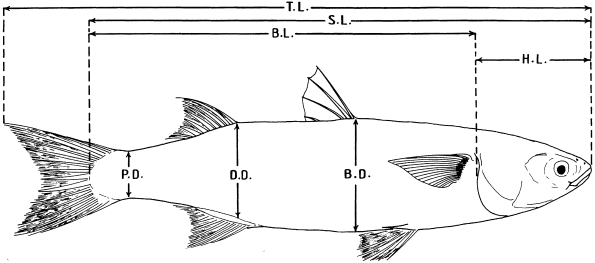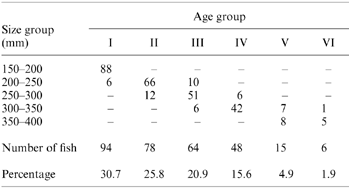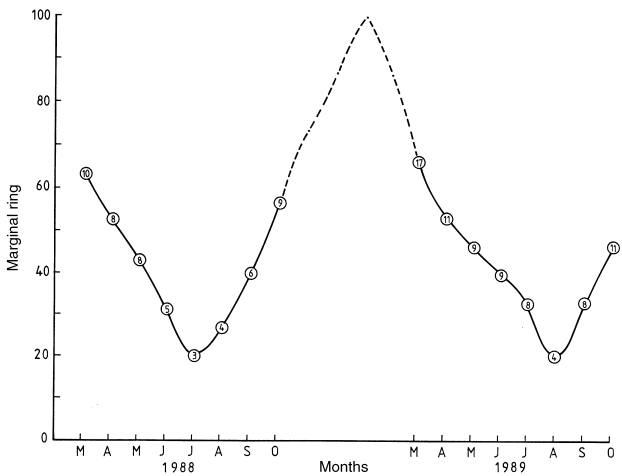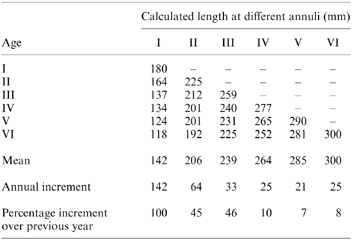A study on some biological characteristics of Mugil cephalus (L.) in Bardawil Lake, Egypt
Abstract
Studies on the morphometric characteristics and the age and growth of Mugil cephalus (L.) of Bardawil Lake, Egypt, showed that the regression of body measurements on total length was linear and revealed that the standard length, pectoral fin depth and dorsal fin depth were different than the caudal peduncle and head length. Age and growth studies also showed that a straight line relation was determined between scale radius and body length as expressed by the following equation: Y =−1.2127 + 1.0850X. Accordingly, M. cephalus attained mean lengths of 14.2, 20.6, 23.9, 26.4, 28.5 and 30.0 cm at 1 to 6 years of age, respectively. Growth of the species is represented by the von Bertalanffy growth equation as: Lt=45[1−exp−(t−to)].
Introduction
In spite of the wide distribution of Mugli cephalus (L.) in several Egyptian waters, the published results on biology and particularly morphometry or age and growth thereof vary greatly in the Bardawil Lake population. The present investigation refers to data of M. cephalus, collected from the Bardawil Lake between March and October during two successive fishing seasons in 1988 and 1989, in order to study and ascertain the stability of their morphometric characteristics, the length–frequency distribution and the calculated age for different sizes. Similar studies on this species were previously conducted in different areas of Egypt ( Bishara 1967; El-Sedafy 1971; Fayek 1973; Hamza 1973; Eisawy 1974 ; Gamee 1996).
Materials and methods
In Bardawil Lake, 644 adult specimens of M. cephalus were sampled during the fishing season from mid-March to mid-October of 1988 and 1989. The fish were drawn from the commercial fish landing at El-Taloul and measured to the nearest mm. Fish scales from 305 fish were uniformly sampled from the region below the dorsal fin and above the lateral line for the total length–scale length relationship. Studies on age and growth were based on the length–frequency analysis and the scale length relationship. Morphometric characteristics were studied according to the method described by Pillay (1957), while the total length to scale radius relationship followed the method described by Bagenal (1978). Morphometric characteristics are explained in Fig. 1.

Different morphometric characteristics of M. cephalus
A linear regression of various body parts against the total length was carried out by the least squares method; the measurements of all characteristics were expressed as a percentage of the total fish length.
The relationship between six various morphometric characteristics on the total length of the studied groups was compared to determine the significance of the differences by using the covariance technique proposed by Mather (1964) and Marr (1955). For age and growth studies, the method developed by Ford (1933) and Walford (1946) for linearizing the von Bertalanffy Growth Function (VBGF) was followed, in which Lt+1 was plotted against Lt, where Lt is the length at age t and to is the arbitrary origin of the growth curve.
Results and discussion
Table 1 shows the regression analyses of different selected body ratios on total length and the significance thereof. The mean standard length, mean head length and mean body length (fish length − head length) were calculated as 83.07, 17.20 and 67.84%, respectively, in the fish sampled during the 1988 fishing season. For the 1989 samples the same ratios were 82.88, 17.44 and 65.43%, respectively.

The standard length and head length of M. cephalus in Bardawil Lake were significantly different from the body length. In the case of depth measurements, it was found that the depth of the pectoral and dorsal fin bases of fish from the two seasons were significantly different. Other body measurements ( Table 1) showed no differences between samples from the two seasons. The variations in the figures of the morphometric characteristics when compared to the results of El-Sedafy (1971), Fayek (973) and Gamee (1996) were due to the different ecological conditions under which the fish were studied.
Table 2 shows the length–frequency distribution for M. cephalus from Bardawil Lake; the percentage of the total number of fish at age 1 was the highest (30.7%), followed by age 2 (25.8%) and age 3 (20.9%), while age 4 was 15.6%. This also means that the age of the majority of the fish that were collected ranged between 1 and 3 years, falling within the 150–350 mm size group in total length.

Studies on age and growth were based on the scale reading and length frequency mode and, when analysed by regression, showed a linear relationship between fish length and scale length. The regression equation representing this linear relation was: Y = −1.2127 + 1.0850X, and sample lengths were 150–450 mm ( Table 2). Back calculations of lengths at different ages, together with the average length at which the annulus length was recorded, are shown in Table 3 where M. cephalus had mean lengths of 14.2, 20.6, 23.9, 26.4, 28.5 and 30.0 cm at ages 1, 2, 3, 4, 5 and 6 years, respectively.
Examination of the outer margin of the scales revealed that rings on the margin occurred only once each year, during the winter season, and that they were true annuli. Figure 2 shows the percentage of scales of M. cephalus, with marginal rings during the age and growth studies conducted. From Fig. 2 it could be concluded that the annuli were added systematically with growth in length of the fish, and that the distance between two adjacent annuli decreased as the fish length increased.

Percentage of M. cephalus scales with marginal ring. (Sample size as numbers inside rings.)
The peak of annulus formation time was masked here, since no data could be collected from November to mid-March, which is the spawning and migration period of adult mullet from the lake to the open sea and when the post-larvae return to the nursing grounds.
From Table 3, the von Bertalanffy Growth Function (VBGF) was adapted according to Ford (1933) and Walford (1946). Lt+1 was plotted against Lt, which led to the estimation of the asymptotic length L to be 450 mm and K = 0.21 years, and thus: Lt = 450(1 − exp[−0.21 − (t − to)]. In this equation, Lt is the length at age t, and to is the arbitrary origin of the growth curve.
From the foregoing results, the regression lines of different body measurements on the total length were found to be linear, reflecting an isometric growth of the fish. This result agrees with the opinion of De Silva (1956).
Significant differences in some of the 1988, &, 1989 samples suggest that the fish may belong to mixed stock of M. cephalus inhabiting Bardawil Lake and the open sea. Such variations are due to the ecological conditions to which this mixed stock is subjected. Similar observations were previously obtained by Royce (1957), El-Sedafy (1971) and Fayek (1973), although in other results observed by Godsil (1948) and Marr (1955) no linear relationship was detected.
The age and growth of the M. cephalus which inhabit Bardawil Lake showed that the annual increment was highest in the fish at age 1 and 2 years, and decreased thereafter. This observation was also attributed to the effects of habitat ( El-Sedafy 1971; Fayek 1973; Gamee 1996). This observation draws its support from the results of ring formations on the scales studied in which the intensity of food and the lower temperature were behind their formation from November to February, a time when fishing restrictions were in effect and the cold winter season was dominant. Thus, it could be concluded that M. cephalus (L.) in Bardawil Lake has isometric growth, which was observed in the biometric studies. The annual growth increment was also higher at ages 1 and 2 years, becoming moderate thereafter. The fish generally reached a large size by the age of 4 years.
Acknowledgements
The author is grateful to Dr H. K. Badawi for his valuable comments while going through the manuscript, and to Miss R. Hussien for the statistical treatment of the data.





